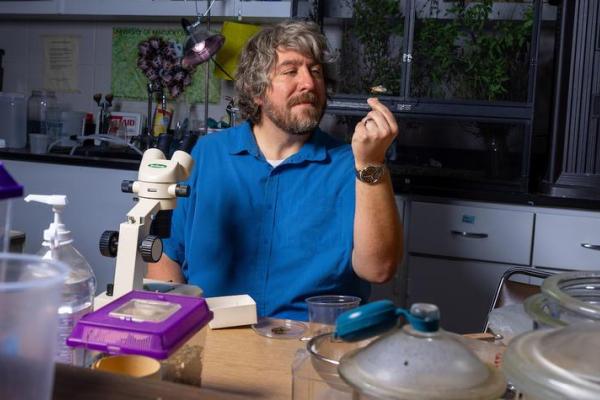UK chemist explores process that turns atmospheric particles yellow after fires

Researchers at the University of Kentucky are studying how the chemical reactions in the air after wildfires contribute to changes in the color of aerosol particles.
Marcelo Guzman, Ph.D., is an associate professor in the Department of Chemistry in the College and Arts and Sciences. He leads the Environmental Chemistry Laboratory.
Guzman, principal investigator, worked with graduate student Sohel Rana on the study funded by the National Science Foundation. Their findings have been published in the journal Environmental Science & Technology.
Guzman and Rana study how chemicals in atmosphere smoke react after a wildfire, human-made disaster or agriculture/industrial processes. The combustion process releases toxic chemicals called phenols that react with compounds already in the atmosphere along with water and air.
Guzman’s research explores those reactions at night, which have not been as widely investigated. The process creates yellowish, toxic nitrophenols in an atmosphere impacted by pollution. The yellowish reaction products are also capable of absorbing sunlight and changing the amount of radiation that remains in the atmosphere.
“No one thought about this frequent chemical process before, which should be quite common in the atmosphere,” said Guzman. “It was generally accepted that atmospheric nitrophenols are produced when gas phase molecules react together, but here we demonstrate that alternative processes for their formation are catalyzed at the interface of water and air.
“Scientists have not considered before the possibility for such reactions to occur at the boundary with air, how they could be initiated or the mechanisms by which nitrate radicals can contribute to such oxidations.”
Once in the air, phenols can directly react with nitrate radicals — a compound made up of oxygen bonded to nitrogen and an important player in reactions between atmospheric components — creating organic aerosols.
“Previous studies were generally limited to explain the role of gaseous nitrate radical as a player that steals a hydrogen atom from a gaseous phenol, which should not be the case when water participates in wetting the surface of aerosol particles suspended in air,” said Guzman.
The study also compared the reactions of nitrate radicals and ozone with the phenol pollutants. The researchers found a flow of electrons from the pollutant molecules to nitrate radicals or ozone is key in the initiation of the process.
Some other organic molecules in the atmosphere may react with nitrate radicals just like these chemicals do at the air-water interface.
“When nitrate radicals attack the pollutant molecules in the atmosphere, the tiny aerosol particles can turn yellow. For example, yellowish secondary organic aerosol can also result from muconic acid, which is a common break-up product from phenols exposed to ozone in air,” said Guzman.
Related studies have shown that the amount of sunlight absorbed by aerosols reveals how much so-called “brown carbon,” which provides the yellow color, is present in the particles.
The researchers also determined that during the chemical reactions in the atmosphere, many types of chemicals are quickly produced, which are key components of brown carbon and increase sunlight absorption.
“Understanding the change in sunlight absorption by these compounds is important because it directly affects the atmosphere’s radiation properties,” said Guzman.
You can find the full paper “Oxidation of Catechols at the Air-Water Interface by Nitrate Radicals” online here.
Research reported in this publication was supported by the National Science Foundation under Award Number 1903744. The opinions, findings, and conclusions or recommendations expressed are those of the author(s) and do not necessarily reflect the views of the National Science Foundation.
Credits
Lindsay Travis (Research Communications)

